Definitive stamps of the Soviet Union
Definitive stamps of the Soviet Union were the regular postage stamp issues produced in the USSR between 1923 and 1992.
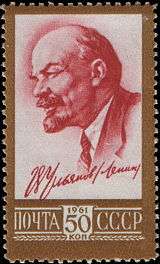
First definitive issue
The first issue of the Soviet Union definitive stamps appeared in October 1923. It was known as the Gold Standard issue. Its stamps bore the busts of the worker, Red Army soldier and peasant. In the period between 1923 and 1926, the worker and soldier designs were placed on thirteen stamps each and that of the peasant on ten stamps.[1]
- Stamps of the 1st definitive, Gold Standard issue, 1923
 Worker
Worker Peasant
Peasant Red Army soldier
Red Army soldier
Other notable issues
In 1929, the third set of definitive stamps was issued. They had new images of the male and female workers, male and female collective-farm workers, and Red Army soldier, reflecting the crucial changes in Soviet society due to industrialisation, collectivisation, and equal women's rights. Depiction of the female worker and female collective-farm worker next to their male counterparts in this series was the first appearance of women on Soviet stamps.[1]
- Stamps of the 3rd definitive issue, 1929
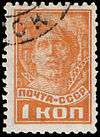 Worker
Worker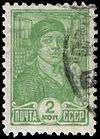 Female worker
Female worker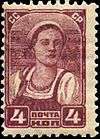 Female collective-farm worker
Female collective-farm worker Red Army soldier
Red Army soldier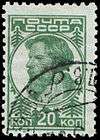 Collective-farm worker
Collective-farm worker
With the progress of the socialistic economic programs, the representation of the major groups of Soviet society changed, moving from the more generic image of the earlier period. The worker was shown in the fifth issue of March 1939 as a steel foundryman and in the sixth issue of August 1939 as a miner.[1]
.jpg) Foundryman, 5th issue, 1939
Foundryman, 5th issue, 1939.jpg) Miner, 6th issue, 1939
Miner, 6th issue, 1939
The last definitive series that begun in the Stalin period was the eighth issue (May 1948 to July 1957). It was remarkable by the fact that the scientist was for the first time portrayed on Soviet definitive stamps. In 1958, the engineer design appeared meaning that representatives of other Soviet labouring groups were also depicted on stamps. In 1961, a definitive stamp with the combine worker appeared.[1]
 Scientist, 8th issue, 1948
Scientist, 8th issue, 1948 Engineer, 9th issue, 1958
Engineer, 9th issue, 1958 Combiner, 10th issue, 1961.
Combiner, 10th issue, 1961.
"Peace will win over war!"
Summary of all issues
This table represents an outline of the overall USSR definitive issues produced in the Soviet and post-Soviet times (1923 – 1992).
| Issue No. | Dates | CPA Catalogue No. | Stamp example |
|---|---|---|---|
| 11 October 1923 – March 1927 | 99–192 |  | |
2 |
October 1927 – October 1928 | 281–295 |  |
3 |
August 1929 – January 1941 | 314–346 |  |
4 |
1936–1953 | 556–559 | .jpg) |
5 |
March – August 1939 | 667–669 | .jpg) |
6 |
August 1939 – December 1956 | 693–701 | .jpg) |
7 |
22 May 1948 – September 1954 | 1247–1255 |  |
8 |
16 October 1948 – 1959 | 1379–1388 |  |
| 18 August 1958 – March 1960 | 2217–2223 |  | |
10 |
1 January 1961 – August 1966 | 2510–2520 |  |
11 |
25 October 1966 – April 1969 | 3414–3437 | |
12 |
10 August – 17 December 1976 8 September – November 1977 4 August 1978 1 December 1980 25 April 1982 12 December 1982 28 December 1982 20 May 1983 15 May 1984 5 September 1984 20 January 1986 25 June 1991 22 August 1991 19 November 1991 20 April 1992 |
4599–4610 4733–4744 4853–4867 5136 5287 5340 5357 5392 5510 5548–5551 5699 6332 5549А 6375 5549.I |
   |
13 |
22 December 1988 25 December 1989 13 March – 25 June 1991 |
6013–6024 6145–6156 6298–6301 |
 |
See also
- 70r Red Army Soldier error
- Definitive stamp
- Definitive stamps of Russia
- First USSR stamps
- Gold Standard issue
- Leniniana (philately)
- List of paintings on Soviet postage stamps
- List of people on stamps of the Soviet Union
- List of postage stamps
- Postage stamps and postal history of Russia
- Soviet and post-Soviet postage rates
- Soviet space exploration history on Soviet stamps
- Soviet Union stamp catalogue
- Stamps of the Soviet Union
Notes
- Stamps of the 9th issue were in use till 1 April 1961.
References
- Grant, J. (July 1995). "The socialist construction of philately in the early Soviet era". Comparative Studies in Society and History. 37 (3): 476–493. doi:10.1017/S0010417500019770. ISSN 0010-4175. JSTOR 179216.
External links
| Wikibooks has a book on the topic of: World Stamp Catalogue/Soviet Union |
| Wikimedia Commons has media related to CPA Catalogue. |
